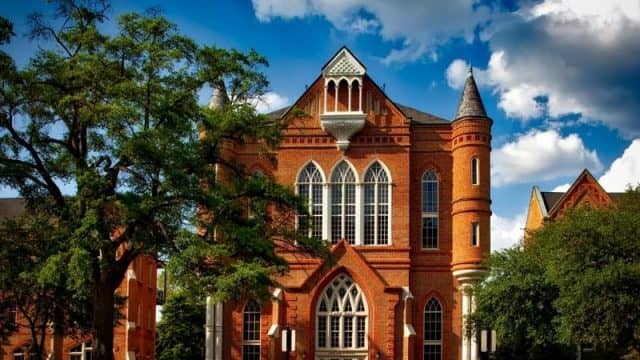Advertiser Disclosure
How to Apply for Student Loans: Complete Guide
Updated On September 7, 2022
Editorial Note: This content is based solely on the author's opinions and is not provided, approved, endorsed or reviewed by any financial institution or partner.

If you’re heading to college or graduate school, then you’ll likely need to know how to apply for student loans. It’s essential to understand all your options, including for both federal student loans and private student loans. Here’s the complete guide for how to apply for student loans.
In this complete guide, we discuss:
- How to apply for federal student loans
- What are the types of federal student loans?
- How much student loan can I get?
- Are private student loans a good idea?
- How to apply for private student loans
Top Picks For Private Student Loans
July 2024
View Details
Overview
Details
- Student loans available to graduate, bachelors and associates degrees
- Deferment and forbearance options may be available
- Grace period for undergraduates: 6 months
- Grace period for graduate students: 9 months
- Flexible student loan repayment options
Review:
View Details
Overview
Details
- Offer college, graduate school, law school, MBA and Parent student loans
- Flexible repayment options
- No late fees
- Autopay rate discount
- Free perks such as career planning and job search assistance
Review:
View Details
Overview
Details
- Low rates from community lenders like credit unions and community banks
- Get lower rates with a co-signer
- Ability to pause payments for up to 18 months if you become unemployed
- May consider your academic credentials to help you get a lower rate
- If you repay 10% of your loan before your loan enters full repayment period, 1.0% APR is dropped from your current interest rate
Review:
View Details
Overview
Details
- Offer student loans for undergraduates, career training, and graduate students.
- Provide private student loans to full-time, half-time and less the half-time students.
- Non-U.S. citizens are eligible for student loans with a qualified U.S. citizen co-signer.
- Multiple repayment options.
- Borrow from $1,000 up to 100% of the school-certified expenses.
View Details
Overview
Details
- Student loans for college, graduate, medical/dental, law, MBA and Parent Loans
- Flexible repayment options
- Multi-year approval: no need to apply annually
- Cosigner option
- Forbearance and deferment options
View Details
Overview
Details
- Student loan repayment while in school
- 1% cash back on student loan principal at graduation
- Co-signer release after 12 consecutive payments
- Financial hardship forbearance available
- No minimum income or credit score
- Apply with or without a co-signer
Review:
Disclosures: College Ave | SoFi | LendKey | Sallie Mae | Citizens | Ascent
How to Apply for Federal Student Loans
Federal student loans are offered by the federal government and should be your first choice for student loans. Federal student loans offer borrower protections that some private loans do not. For example, if you can’t afford your monthly student loan payments, you can choose an income-driven repayment plan. If you lose your job or return to school, you can temporarily pause your payments through forbearance or deferment.
Here is a step-by-step guide for how to apply for federal student loans:
1. Create a new Federal Student Aid (FSA) ID.
You can apply for an FSA ID on the Federal Student Aid website. An FSA ID is a username and password that gives you access to Federal Student Aid’s online system. With an FSA ID, you can sign documents electronically and access your student loan report.
2. Complete the Free Application for Federal Student Aid (FAFSA)
The Free Application for Federal Student Aid (FAFSA) is the application to apply for federal student aid. The FAFSA has no fee and is released each October. You should complete the FAFSA as soon as possible after January 1. The FAFSA is used by colleges and universities to determine your eligibility for federal financial aid, state financial aid and school financial aid. You must complete a FAFSA the year before you first attend school and every year that you attend school. Importantly, if you’re a dependent college student, both you and your parent must sign the FAFSA.
To complete the FAFSA, you will need certain personal and financial information, which may include the following:
- Your parents’ Social Security Numbers
- Your parents’ date of birth
- Your parents adjusted gross income for the last two years prior to attendance
- Your parents’ tax returns for the last two years prior to attendance
- Your tax returns (if applicable) for the last two years prior to attendance
- Your parents’ net worth
- Your net worth (if applicable)
- Any scholarships or grants you have received
- Whether your or your family receive Medicaid, Supplemental Social Security, Temporary Assistance for Needy Families (TANF), and related programs.
3. Review your Student Aid Report (SAR)
Once you file your FAFSA, you will receive a Student Aid Report (SAR). You should review the Student Aid Report to ensure that it is accurate. You can also include additional colleges that you would like to receive your Student Aid Report. The Expected Family Contribution (EFC) portion of your Student Aid Repot will be shared with financial aid offices at the schools to which you applied or attending. Your Expected Family Contribution is how much your family will be expected to contribute toward the cost of your school. The financial aid office will determine your financial need based on your Expected Family Contribution. The amount of financial need for which you qualify may change by college or university.
4. Compare financial aid award letters
Each college or university will send you a financial aid award letter. Types of financial aid may include scholarships, grants, work study and student loans. Not every school can meet all your financial aid needs. That’s why it’s important to compare financial aid award letters. Financial aid is not the only reason to select a school, but it may be an important factor for you. Any financial shortfall between the total cost to attend a school and your financial aid package needs to be supplemented with other financial sources. You can apply for scholarships, borrow private student loans or find other sources to pay for school. You can also appeal your financial aid award letter by contacting your school.
5. Sign your promissory note
Your school likely will include federal student loans in your financial aid package. To borrow federal student loans, you will sign a master promissory note, which is a legally-binding contract regarding the terms and provisions of your student loans and your promise to repay them.
What Are the Types of Federal Student Loans?
Your school likely will include federal student loans in your financial aid package. To borrow federal student loans, you will sign a master promissory note, which is a legally-binding contract regarding the terms and provisions of your student loans and your promise to repay them.
Direct Subsidized Loans
Direct Subsidized Loans are federal student loans for undergraduates who have a demonstrated financial need. While you are in school, you will not owe any interest on these federal student loans. The federal government pays the interest for you.
Direct Unsubsidized Loans
Direct Unsubsidized Loans are available to both undergraduate and graduate students. Unlike Direct Subsidized Loans, interest accrues on these student loans while you’re in school and you are responsible to pay for this interest. You don’t have to pay the interest while you’re in school, but the interest will be capitalized at the end of your six-month grace period after graduation. Capitalized means that your total interest will be added to your student loan balance.
Grad PLUS Loans
Grad PLUS Loans are federal student loans for graduate and professional students. Unlike subsidized and subsidized student loans, there are no borrowing limits for Grad PLUS Loans. To borrow Grad PLUS Loans, you cannot have an adverse credit history.
Parent PLUS Loans
Parent PLUS Loans are federal student loans that parents can borrow for a dependent child to pay for undergraduate education. There are no borrowing limits for Parent PLUS Loans.
How Much Student Loan Can I Get?
Many borrowers ask: How much can I borrow in federal student loans?” With federal student loans, there are maximum amounts that you can borrow. With private student loans, borrowing limits are set by the lender. Typically, you cannot borrow more than the total cost of attendance. Cost of attendance includes tuition, fees, room and board, books and other materials for school. The amount of federal student loans that you can borrow depends on three main factors:
- The type of federal student loan
- Your year in school
- Whether you are considered a dependent or independent student
In addition to annual borrowing limits, there are also total borrowing limits for the duration of your higher education.
Subsidized and Unsubsidized student loans
Direct Subsidized Loans and Direct Unsubsidized Loans each have annual and total borrowing limits. Your total borrowing limit is the amount of federal student loans that you can borrow during your undergraduate and graduate school.
Subsidized vs. Unsubsidized Loans: Annual Loan Limits
| Dependent Students | Independent Students | |
|---|---|---|
| Undergrad: 1st Year | $5,500 (up to $3,500 may be subsidized loans) | $9,500 (up to $3,500 may be subsidized loans) |
| Undergrad: 2nd Year | $6,500 (up to $4,500 may be subsidized loans) | $10,500 (up to $4,500 may be subsidized loans |
| Undergrad: 3rd Year | $7,500 (up to $5,500 may be subsidized loans) | $12,500 (up to $5,500 may be subsidized loans) |
| Undergrad: 4th Year | $7,500 (up to $5,500 may be subsidized loans) | $12,500 (up to $5,500 may be subsidized loans) |
| Graduate or Professional | N/A | Yes $20,500 (all unsubsidized) |
| Aggregate Limit | $31,000 (up to $23,000 may be subsidized loans) | Undergrads: $57,500 (up to $23,000 may be subsidized loans) Graduate/Professional: $138,500 (up to $65,500 may be subsidized loans) |
Grad PLUS Loans
There are no limits to the amount of Grad PLUS Loans that you can borrow. The maximum amount typically is limited by the total cost of attendance. PLUS Loans have higher interest rates than Direct Subsidized Loans and Direct Subsidized Loans. Therefore, you should borrow the maximum amount of subsidized and unsubsidized student loans before you borrow PLUS Loans.
Parent PLUS Loans
Like Grad PLUS Loans, Parent PLUS Loans do not have borrowing limits. However, like PLUS Loans, Parent PLUS Loans are typically limited by the cost of attendance. Parent PLUS Loans typically have the highest interest rates. However, you can refinance Parent PLUS Loans to get a lower interest rate.
Are Private Student Loans a Good Idea?
Private student loans are student loans that are available from private lenders such as banks, credit unions and online lenders. Private student loans are not issued by the federal government so they different from federal student loans in some ways. For example, private student loans do not offer income-driven repayment plans or student loan forgiveness options. Private student loans also require good credit. Unlike federal student loans, lenders require either a good credit score or, if you have a bad credit score or no credit history, you can applya cosigner with a good credit score.
Private student loans have several benefits. Typically, private student loans have lower interest rates than federal student loans. This can help save you money and pay off student loans faster. Unlike federal student loans, which only offer fixed interest rate, you can choose a private student loans with either a fixed interest rate or a variable interest rate. Many lenders now allow you to pause your private student loan payments if you lose your job or face financial hardship. Typically, it’s best to maximize funding from other sources such as scholarships, grants and federal student loans before you borrow private student loans. However, many borrowers pay for school with private student loans after any money received for financial aid.
How to Apply for Private Student Loans
You can apply for private student loans directly online. You can compare private student loan lenders, interest rates and loan terms to find the best private student loans for you.






